So the first project task for Foundation 2D has been assigned and it’s to create 6 expressive lines to evoke 6 different emotions.
First thing first is to do some research.
What is Mark Making?
Mark making is a term used to describe the different lines, patterns, and textures we create in a piece of art
(Quoted from https://www.thoughtco.com/how-does-mark-making-affect-your-paintings-2577630)
As the article states, Mark Making is a technique that encompasses any form of mark that is created on a piece of paper with any object.
Sounds simple enough, but having an infinite number of ways to create marks on a piece of paper makes it difficult to know where to start.
So let’s look at some of the techniques that other artists have used to create their works.
Ed Moses

One of the first paintings that Ed Moses did was during an still life art class where he used his fingers to paint after being terrified by the critique that the teacher was giving other students.
The work that he has produced, something closer to that of abstract expressionism, was different from the others. Not only did it stood out, it also became iconic in his art style throughout his career.
“Just look. Don’t think. Don’t extract some ideas or some meaning. It doesn’t have any meaning — it is what it is. You’ll just look on the wall and see what it is,” – Moses, in an interview
(Quoted from http://www.scpr.org/programs/the-frame/2015/05/29/42820/ed-moses-says-he-doesn-t-make-art-he-makes-magic/)
Here are some of his works:
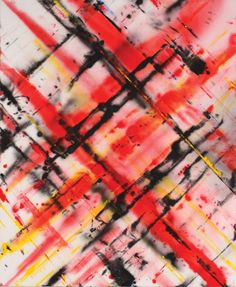
I really like how some simple lines that Ed Moses have dashed across the canvas here and there can create something that is so astonishingly pleasing to look at.
The color contrast between the reds and blacks gives the painting impact to the eyes. While the hints of yellow really complements the other 2 colors to bring about flavor to the work.
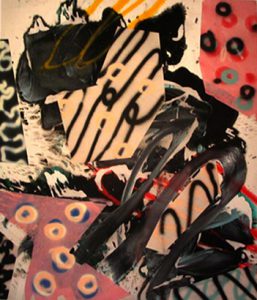
Patterns.
Different patterns brings about different meanings and what Ed Moses have did here is to make a sort of collage of different patterns to create this labyrinth of feelings.
It is amazing how the viewer’s perception of the painting changes as his or her eyes darts from one point of the painting to the next.
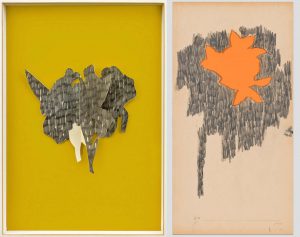
Negative spaces.
Ed Moses is playing around with empty spaces in the canvas to give emphasis on shapes and textures found in this work.
I amazed by how the sudden transition from the blank canvas to the marks produced by graphite can give significance to the shaped produced by the marks.
The small little shapes that have a sharp color difference from the canvas and graphite adds a neat little “special” touch to the work
“Moses was making drawings where he would try and press so hard on his drawings that supernatural light would come out of them”
(Excerpt from https://www.kcet.org/shows/artbound/ed-moses-the-compulsive-creator)
Learning points
Seeing how dynamic strokes and patterns can create impact, I would try to emulate them in my mark-making process. Especially so on the stronger emotions such as “Anger” and “Joy”
I would also strive to incorporate the usage of negative space to emphasize the shapes or patterns that i will be creating on the canvas.
Cai Guo Qiang
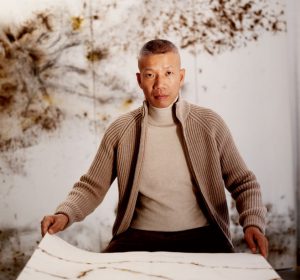
Cai Guo Qiang is a Chinese artist born in Quanzhou, Fujian Province, China.
Cai lived through the Cultural Revolution of China where explosions were common, whether they were the result of cannon blasts or celebratory fireworks which has had an influence on his choice of using gunpowder in his works.
Some of Cai’s works:

Most of Cai’s works incorporates real life objects such as animals and buildings, but in the spirit of the project task in hand, i have opted to refer to some of his works that are more abstract in nature.
The above work was done by exploding gunpowder on the canvas to give a very expressionistic feel to the marks. I really like how the marks look so messy and dispersed but yet feels controlled.
The little splatters of marks around the general cluster gives the work a striking impression as it makes the marks look like they are popping out of the canvas.
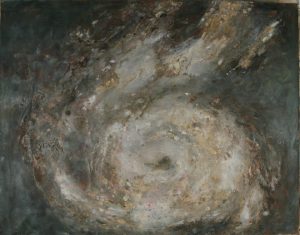
This is one of Cai’s earlier works before he started working with gunpowder.
It is created by laying oil paint on the canvas and blowing it with air from an electric fan.
I find this extremely intriguing as it is a whole new way of making marks on a canvas which is not commonly found in other artists’ works.
Not only is the technique interesting, but the marks created are these smooth, natural ink dashes that is exceptionally difficult to reproduce with the usual human hand-and-brush.
“The key is to focus on the process of fabrication of these artworks, to pay attention to the process of the artists making these sculptures, rather than where these sculptures will end up and how they will look in the end.” – Cai Guo Qiang in an interview with the Brookln Rail
(http://brooklynrail.org/2008/04/art/cai-guo-qiang-with-ellen-pearlman)
Learning points
From Cai’s works, it is evident that a great looking work need not be produced by physically pressing or brushing an object on the canvas by hand but can also be done by using external factors such as explosions or wind.
I would want to attempt to replicate this notion by including some techniques that involves getting ink onto the canvas without the condition of contact between the mark-making object and the canvas in my work.

